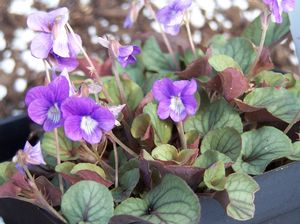View All Plants :: View All SHADE PERENNIALS
Viola walteri 'Silver Gem'
Prostrate Blue Violet
Plant Type:
SHADE PERENNIALSViola walteri 'Silver Gem' (ex: Jonathan Lehrer) - A lovely mat-forming to slightly mounding violet with silvery foliage nicely demarcated with green veining. Though generally not much seen leaf undersides are a deep, rich purple. However, some leaves do cup offering glimpses of the beautiful, contrasting purple. Early in the growing season typical violet-blue flowers rise above the silvery leaves. This perennial can bloom repeatedly with successive flowering into the autumn. It is a dense, neat and tidy grower introduced by Mt. Cuba Center in northern Delaware. Best planted in fertile soil in full to part shade. Often found growing in calcareous conditions the addition of dolomitic limestone may be helpful. The species ranges from Florida to Texas, north to West Virginia, into southern Ohio, Kentucky and Arkansas. 'Silver Gem' has good drought tolerance once established. Pot grown Division.
Robert M. (AL) on 10.18.2013 - Wayne, The Viola walteri ['Silver Gem'] came today. Very nice healthy plants, and I'm very happy with them. This plant has proven particularly hard to find for me, so I was delighted when I found it for sale on your website. I'm positive I will be a return customer. Have a good one. Robert
Characteristics and Attributes for Viola walteri 'Silver Gem'
Season of Interest (Flowering)
- Spring / Summer / into Autumn
Season of Interest (Foliage)
- Spring / Summer / Autumn
Nature Attraction
- Deer Resistant
- Honey Bees & Native Bees
Light
- Morning Sun / Afternoon Shade
- Dappled Shade
Attributes
- Natural Garden
- Edging
- Potted Plant
- Massing
- Woodland
- Rock Garden
Growth Rate in the Garden
- Medium
Soil
- Fertile
- Calcareous
Origins
- Garden Origin
Propagated By
- Division


